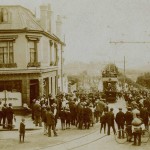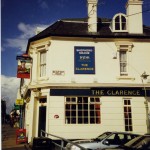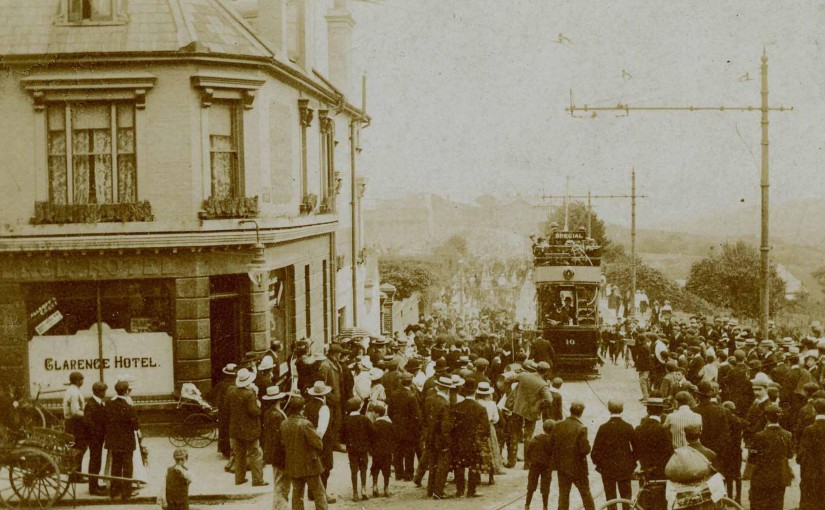CLARENCE HOTEL
By John Hodges
The first reference to the name Silver Hill, it was spelt as two words until about 1865, occurs in 1783 when High Ridge Farm changed its name to that of Silver Hill Farm. The name next occurs in 1813 when the name of Silver Hill Mill first appears on the ordnance survey map, but little more is heard of this mill until 1838 when John Harmer brought to the site one of the mills that had stood on the West Hill. Despite a series of catastrophes and subsequent reconstructions this old mill struggled on until 1966 when the crumbling structure was finally demolished. In the early years of the nineteenth century Silver Hill was open countryside, it was not until 1836 that the original Tivoli Hotel was opened together with its pleasure gardens and a programme of scenes from Shakespeare illuminated by displays of pyrotechnics rivalling the best to be found anywhere. In 1836 a turnpike was constructed, linking the new town of St.Leonards with other important routes, notably the London Road where it passed through Baldslow and providing access to several significant villages on the way to Hawkhurst Moor. This new road undoubtedly acted as the catalyst in the development of Silver Hill, and in 1837 Silver Hill Terrace was built to accomodate the artisans who were now moving into this rural suburb of both Hastings and St.Leonards. With this new influx of available Labour the nature of Silver Hill began to change from what was an essentially rural district until this time, when a pottery was opened by the Eldridge family, who were the brewers and owners of the old St.Leonards Brewery in Shepherd Street. This venture lasted until 1886 when the pottery fell into disuse, and by 1900 all traces of the building together with the cottages that were attached had disappeared.
With the creation of the Tivoli Hotel and tea gardens in 1836 the whole area became loosely known as Tivoli. However with the demolition of the original Tivoli Hotel in 1860, and the construction of the short lived Silverlands House, the area gradually dropped all reference to this name, and it became popularly known once again as Silver Hill. By 1865 even this two word spelling was superceded by the single word designation Silverhill, by which title it is known to this day.

As Silverhill developed beyond a mere turnpike interchange it was not an unnatural progression for much speculative building to take place in the area. Amongst the earliest developers were those who would cater for the bibulous needs of this ever growing population, fuelled by work both in the fields and in some of the newly emerging businesses. The beer house in Silverhill Terrace that subsequently became the Silver hill Tavern was the first to open in the area, and by the 1870’s was joined by four other licensed premises in quick succession. The Clarence Hotel was one such establishment when it was constructed as the end property of a small row known as Clarence Terrace. It first opened its doors in 1869 as a public house combined with the business of a wine and spirit merchants and further extended its range of amenities in 1876 by offering coach housing and lock-up stabling. The original building had four bars, a common feature in many Victorian pubs reflecting the ever present class awareness of the age. Over the years this abundance of bars has gradually diminished until in 1984 the Clarence finally joined the ranks of the “one bar” houses.
In 1900 Clarence Terrace was incorporated into London Road its present address, and the Clarence itself became known as The Clarence Hotel and Tap. The first Landlord was George Fisher who came from a well known Dining Establishment in the town and he held the License for almost 20 years. . In terms of other Landlords the longest association with the pub by far has been with the Burnett Family, father and son holding the license for almost sixty years.
The earliest beer sold in the establishment would certainly have been taken from one of the local brewers such as Hewetts of St.Leonards, with its connections to the Silverhill Pottery, or Bailys of Battle who we know were already delivering in the area to the Dorset Arms. But the first recognised tie with the House came via Ballards, the Lewes Brewer who bought several pubs in the area including the twelve owned by Bailys of Battle. Ballards were taken over in 1924 by Page and Overton who in turn became part of Hoare and Co. some five years later, although still trading under the Page & Overton banner until the last major brewery owners Bass/Charrington came on the scene in 1954. Following the Lord Young’s report on the tied house system The Clarence, along with a number of other local pubs was purchased by Shepherd Neame the Faversham brewer. Today the Clarence remains a pleasant and typical street corner hostelry, but free of tie to any brewer.

When discussing the other side of the bar and long associations, one is led onto the name of Arthur Booth, who in August 1985 celebrated 60 years of drinking in the Clarence. Arthur, a confirmed bachelor, having love and affection only for his pint of Toby, can recall most of the recent history of the pub first hand. In celebration of this significant milestone Bass/Charringtons the owners at that time presented Arthur with his own barrel of his favourite tipple, with just one difference the tap being on his side of the bar ! The other significant attribute of The Clarence was its extremely successful quiz team. Having won local honours they went on to win several competitions at a regional level, and finally won the first ever national pub quiz. This all happened under the stewardship of Richard Gillitt another long serving and very popular landlord, who went on to gain further personal honours at the Dripping Spring, this time the question master was CAMRA, and the answer was a great pub selling a range of fantastic beers.
Hastings Town October 2012
All articles, photographs, films and drawings on this web site are World Copyright Protected. No reproduction for publication without prior arrangement. (Hard Copy Back Numbers Still Available) © World Copyright 2016
